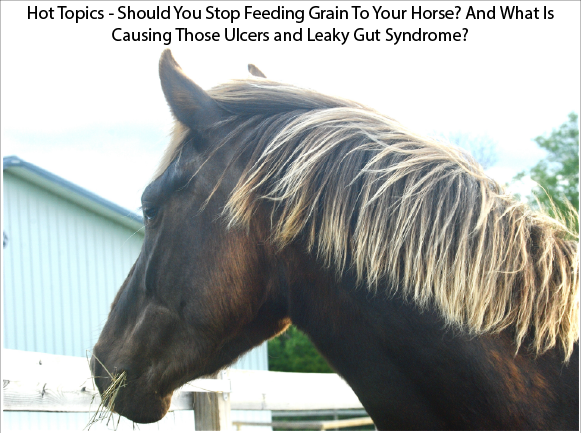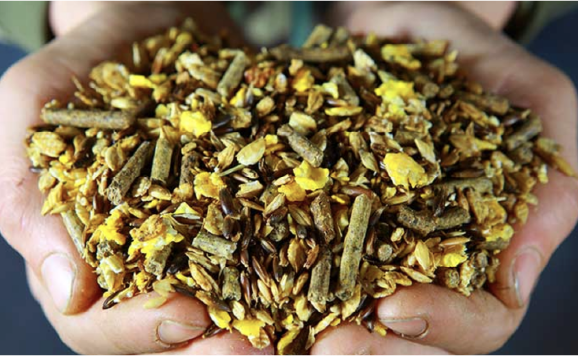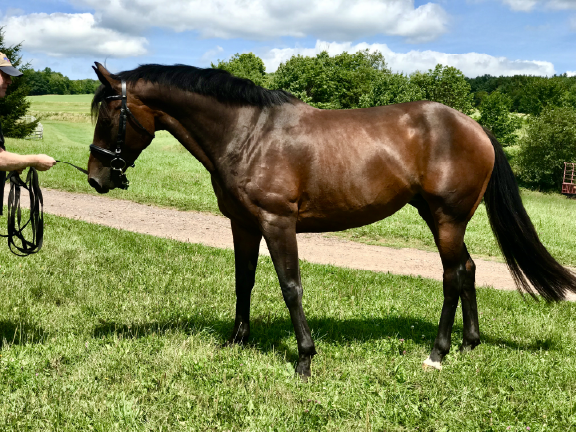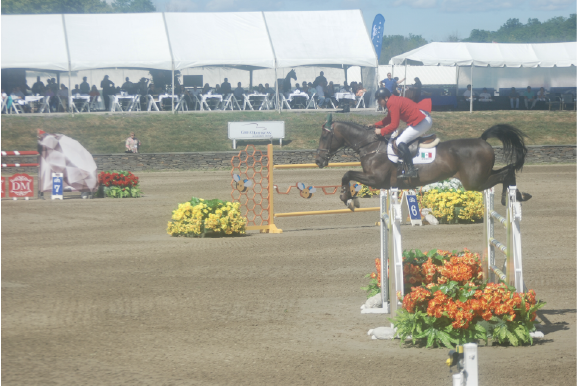Hot Topics -
Should You Stop Feeding Grain To Your Horse?
And What Is Causing Those Ulcers and Leaky Gut Syndrome?
Answers here from the popular Grand Meadows Cares Series…
By Nikki Alvin-Smith

If there was a nose to tail travelogue that took a trip through your horse’s digestive system would you be interested in reading it? Imagine it up on the big screen. Would you like to see it? And if you would, what do you think you might find?
It is highly likely that the findings would depend on what year the ‘guidebook’ was published. Horse owners all understand that gastric ulcers in their equine charges are a frequent issue, today more than ever before. The racehorse population suffers the worst, with their high grain diets and lack of forage first nutrition, and performance horses of all types come a close second. Perhaps it is time to figure out why Equine Gastric Ulcer Syndrome {EGUS] is debilitating our horses and fix it.
Grains and History
In London the 1960’s were known as the Swinging Sixties, and according to many American scholars the ‘cultural decade’ was a time of robust change in the 20th Century. Those changes were not just in Civil Rights, Women’s Rights, Counterculture and the rest. As an outgrowth of post WWII the ‘golden age’ that was promised came transformations across many industries. These changes included farming and the feed industry where the continued 1940’s and 1950’s pelleted feed rations were developed and became increasingly complex.
The history of how the grain we feed our horses today became a conveniently pre-mixed extruded compound in a bag is an interesting one, aptly noted here by the University of Cambridge, UK. And not only did the well-meant practices of not just providing grains, but also including a ‘one source fixes all’ feed with vitamins, minerals, amino acids and the rest, become popular as an answer to nutritional management of horses, in the 1960’s and 1970’s farmers also started discovering other helpful production growth practices, such as the widespread use of fertilizers, chemical pesticides. Yummy.

The advent of NIR technology and incorporation of other technologies should theoretically make the feed mill itself smarter. Toxins should be readily identifiable before the feed leaves the premises rather than later discovered by the horse owner when their animals become unwell or die, and digestive modelling systems should help define nutrient interactions and values.
Trouble Is….
The continued research and development that spun forward from heavy sugared sweet feed concoctions that found popularity in horse barns in the 1960’s on to what you can buy in today’s horse grain marketplace hasn’t been explained to the horse’s digestive system. The trouble is, “no-one told the horse.” Adapting to the ongoing somewhat ‘unnatural’ synthetic formulations of certain vitamins for example is not something easily monitored in the horse as a factor in its well-being. Think about the chemicals that find their way through the food chain, that should perhaps be ‘Rounded Up” themselves and eliminated from use, rather than just renamed, reframed and rebranded.
As an organic hay farmer myself for the past 24 years, I am obviously much biased toward keeping things as horse-friendly as possible. As a horse breeder of performance horses and professional horse trainer competing and producing horses from birth to Grand Prix for three decades together with my similarly qualified husband Paul, I am extremely proud to mention that none of our horses have ever exhibited any signs of EGUS. I’m not saying there couldn’t be a single case I could have missed. I’m just saying I’m aware of the disease and its symptoms and have not seen it in our horses. I’ve seen it evidenced when giving clinics in other people’s horses, and of course am aware that a horse can develop it at any time. Neither has any horse we’ve sold from our breeding or training program that received a pre-purchase endoscope exam been diagnosed with the disease.
A forage first diet( given it is clean and green, organically grown and also importantly, and dry forage is organically harvested/cured and stored, and certainly not pre-mixed and preserved with chemicals) is a horse-friendly diet. We all know that. At our farm we feed minimal amounts of grain. Our home-produced hay is always available to stabled horses on an ad lib basis. Ad lib because actually our belief in, and need for, top quality organic hay, was why we started the business and moved to our present farm with south-facing tillable land in the first place and we understand the horse’s need for plenty of it. Additionally our horses enjoy life grazing and living outside as much as possible, including the advanced level ones, on carefully managed (read dewormed, topped/harrowed/organically limed and annually tested) pastures as much as possible.

I Can’t Explain It All – But Nick Hartog Can. And Does.
I admit that part of being a horse owner for me, and indeed a human being on this temporal plane, includes an acknowledgement that earlier in life I may have had some ‘wannabe’ moments. And perhaps I do like to ‘disrupt’ by bringing controversial topics to light.
I was for sure, always interested in animal nutrition and farming.
As a ‘wannabee’ in my idealistic late teen state, I wanted DDT spraying to be banned following my read of Rachel Carson’s iconic Silent Spring title, a controversial read back then. I also endeavored to follow a career to help mitigate world hunger (I was an avid reader of National Geographic and still am).
This ‘wanna make a difference’ person that was my younger self had such ideas squashed rather abruptly after I spent a year working as an Assistant Scientific Officer at the U.K. Ministry of Overseas Development. The mission of that government entity was partially to help developing countries figure out more productive farming protocols that were less damaging to the environment but would produce much needed food for their populations. I won’t mention the obvious political side to this effort that of course I was to realize as I grew up a bit and discovered the bigger picture.
There was certainly a point when I was a ‘wannabe veterinary surgeon or doctor of human medicine’, and those interests have never left me. Even if the illusion that I had the grades and mental toughness to qualify for those esteemed professions faded when my A-level results hit the street.
The point is, that we all strive to make the world a little bit better. And as a horse owner, that’s where I landed – I was always a writer at heart with a passion to share knowledge. So here I am. Trying to share what I’ve learned to make things better. And based on that, I urge horse owners everywhere to take a few moments each day and hit up your social media to learn for yourself ‘what tracks’ in resolving EGUS and other issues in our horses, in the informative “Supplement Savvy” series hosted by Grand Meadows President Nick Hartog.
You’ll be surprised at how barn owners and horse trainers number one horse health concern, that of equine digestive issues with gastric ulcers, can be better handled to support the well-being of the horse. And as I’m also fond of saying, “Horses can’t read or use a smartphone, so it’s up to you.”

Tossing Around Proton Pump Inhibitors Like Candy - Are You Healing or Hurting Your Horse?
Extensive use of Proton Pump Inhibitors {PPIs} in the horse world has become epidemic. The alarming number of equines that are clinically diagnosed via endoscope with gastric ulcers {EGUS} has given rise to use of these drugs on an ad hoc basis.
Unfortunately not following the manufacturer’s instructions for timeframe of use or adherence to administration protocols brings with it other issues, such as Rebound Acid Hypersecretion. Sounds technical and it is, but understanding whether we are healing or hurting our horses by tossing around PPIs like candy is a practice that horse owners need to address.
Bad Habits Founded On Good Intentions
Back in the day I founded and operated a successful international equine transportation division for the freight forwarding company I worked for based in New York. Our team would transport horses around the globe. Horses of all ages, genders, and backgrounds travel via airfreight. We shipped vulnerable mares and foals, racehorses, advanced level performance horses across multiple disciplines and youngsters purchased from the elite European auctions that were just starting their careers. It was exhausting but it was fun, and I learned a lot.
Part of that experience included seeing firsthand what my fellow professional horse trainers and their owners would do to help their horses deal with the inevitable difficulties that flying horses involves and the risks that it poses for their well-being.
When you load a 1500-pound creature of flight into a small metal ‘biscuit tin’, then lift that rather flimsy lightweight container into the air on a scissor lift and roll the box into the belly of an aircraft, there is an abundance of issues with the noise and movement of the pallet that the horses have to contend with during this process. Regardless of how much effort is spent trying to avoid steep ascent and descents of the flight at take-off and landing, or the talents of the flight crew to steer clear of turbulent routes, the permanent shifting left to right action that a plane presents to the horse during flight, takes a toll on the equine both physically and mentally. Horses typically respond to all this melee in one of two ways, they either arrive at their destination wound up and excitable or they switch off and become unusually calm and quiet. Horses can easily become overwhelmed with excessive input and shutting down is a defensive mechanism. Thankfully, once equines are returned to a normal horse-friendly lifestyle most recover from their travel experience quite quickly.

Everyone involved in the airfreight process did their best to make transport as safe and comfortable as possible for the horses in their charge and for the majority of the time things usually went well. But occasionally unfortunate happenings would occur, sometimes during and sometimes after the flight.
Before the stress of air transport horse owners would commonly treat their horses with all sorts of remedial action administering medications or supplements before the horses even took flight. This random administration included everything from PPIs to prebiotics to dewormers to warm bran mashes to Vicks cold remedies smeared on the nostrils of stallions and other things we as their temporary caretakers were likely not aware of at all. All these efforts were attempts by caring horse folk to offer a proactive approach to try and help mitigate the risks of what might befall the stressed equine during or immediately following travel. These activities were well-meant for sure, but perhaps these misplaced attempts to make things better inadvertently made them worse in certain cases.
We can all look back with 20/20 vision at things that we, as supposedly knowledgeable and caring horse folks, have done with our horses.
Some examples: we have all been made aware that horses now suffer with resistance issues related to rotational use of present day marketed deworming products. A practice that was once the mantra for executing a responsible deworming program. Research has shown us that blindly deworming a horse without accurate and regular fecal worm counts is not the best solution to eradicate worms in horses. Similarly, the days of boiling down linseed oil (to remove toxins) and then adding it to a bran mash fed to the animal before travel has also been found to offer questionable benefits to support the well-being of the horse.
It is true that old habits or bad habits do die hard. Every horse person is loathe to abandon what they feel works best, especially in times of perceived need. For myself it is adding a pint of Guinness to a grain ration that has been softened with warm water when the horse seems slightly off color. But the old ways or even the new ways, aren’t always the best way forward.
To be frank I’m not sure much has changed in regard to horse owner’s habits in regard to PPI use, even though the rampant misuse of the products have been shown to pose hazards to the well-being of the horse. And of course their flagrant use is also a waste of money. Off to the horse show? Then let’s load up the horses with PPIs. Off to the breeding shed? Let’s load up with PPIs. Off to the trainer’s yard? Let’s load up with PPI’s.
What Do You Know About It?
Improvements in horse management and care come with assimilation of accurate information and education. In the airfreight industry many changes in how horses are moved around the world include aircraft noise cancellation and improved ventilation systems, new containment options, better designed loading facilities and many others. All improvements are based on research into what made life better and safer for the horses and the aircraft operator and the human crew.
Similarly, research into the horse’s digestive system is constantly improving the well-being of the horse, though it is of course a complicated subject to fully understand. Its dynamic state leaves much to be learned and spawns endless chat about microbiome activities and what affects what, and when.
In regard to PPI use consider that glandular and non-glandular areas of a digestive system are subject to either protection from hydrochloric acid or are vulnerable to it. In human medicine the use of PPIs and the pluses and minuses that come with long term use and how the body reacts when their use is suddenly stopped is certainly well documented. Should you be worried about suggestions of increased risks of bone fractures, pneumonia, enteric infections, vitamin and mineral deficiencies and kidney disease with misuse of PPIs? In my humble opinion there is a scientific approach to the use of PPIs that can be easily understood and then addressed by the horse trainer/owner.
Easy To Understand Answers
It is time to stop tossing around PPIs. Horse owners that better understand the equine digestive processes and how PPIs fit into solving the EGUS issues and what post care help supports the well-being of the horse, are leagues ahead when it comes to solving EGUS issues. Why not become one of them?
 Take a few moments each day and hit up your social media to learn for yourself ‘what tracks’ in the informative “Supplement Savvy” series hosted by Grand Meadows President Nick Hartog – in particular check into this episode and follow along.
Take a few moments each day and hit up your social media to learn for yourself ‘what tracks’ in the informative “Supplement Savvy” series hosted by Grand Meadows President Nick Hartog – in particular check into this episode and follow along.
You’ll be surprised at how barn owners and horse trainers number one horse health concern, that of equine digestive issues with gastric ulcers, can be better handled to support the well-being of the horse.
About Grand Meadows: Founded in 1989 by visionary Angela Slater, Grand Meadows is a leading horse health product and equine supplement manufacturer driven by the guiding principle of providing affordable, extremely high-quality science-backed horse products to help ensure horses look and feel their best.
For the past 35 years the company’s mission has been honored and developed further, by President Nick Hartog, who among other accomplishments is one of the founding members and current board member of the National Animal Supplement Council (NASC), an organization that has a profound impact on the safety, transparency, and legitimacy of the animal supplement industry.
Grand Meadow products are widely used and trusted across the entire horse community from Olympic medal winning competitors and successful horse racing trainers to backyard horse owners. Their equine supplements are highly regarded for their excellent quality resourced ingredients and completely accurate labelling and effective formulations. Learn more at https://www.grandmeadows.com/

About Nikki Alvin-Smith:
Content Creator | PR Partner | Seasoned Writer | Brand Builder |
Major Marketer| Journalist|
Blogger| Ghostwriter|
PR Marketing Specialist/Strategist|
British American|
Grand Prix Dressage
Competitor/Coach/ Clinician|
Please visit https://www.horseinakiltmedia.com/ and https://nikkialvinsmithstudio.com/ to learn more about her affordable services.



